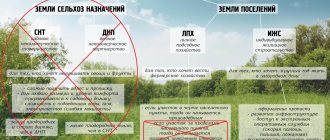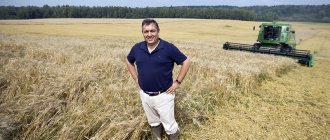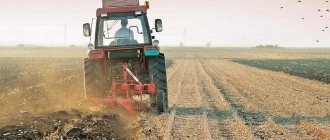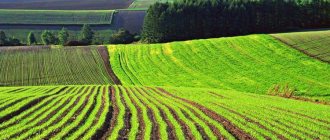The Supreme Court recalled the procedure for the use of agricultural land by persons with subsidiary plots
The Supreme Court published a resolution in case No. 89-AD21-10-K7 on appealing administrative liability for the use by a citizen of a land plot belonging to her for other than its intended purpose.
In November 2021, the deputy chief state inspector of the Tyumen region for the use and protection of land fined Nadezhda Khlystunova 10 thousand rubles. according to Part 1 of Art. 8.8 Code of Administrative Offenses of the Russian Federation. The landowner was accused of keeping farm animals and poultry on the property with the permitted use “for gardening and vegetable gardening.”
Since the courts agreed with the inspector's decision and recognized violations of the Land Code, Nadezhda Khlystunova filed a complaint with the Supreme Court. Demanding that the acts of the lower courts be cancelled, she, in particular, referred to the Resolution of the Constitutional Court of the Russian Federation of October 16, 2021 No. 42-P on checking the constitutionality of Part 1 of Art. 8.8 Code of Administrative Offenses of the Russian Federation.
Accounting in agriculture: general principles
For agricultural enterprises, all general principles and rules of economics and accounting in force in the Russian Federation are applicable. This:
- Federal Law “On Accounting” dated December 6, 2011 No. 402-FZ;
- chart of accounts approved by order of the Ministry of Finance of Russia dated October 31, 2000 No. 94n;
- complex of PBU and FSBU;
- other regulatory documents governing accounting in the Russian Federation.
Features of reflecting agricultural operations in accounting are associated with their special characteristics:
- seasonality;
- long production cycles;
- a large share of turnover within the enterprise, etc.
On-farm turnover in agriculture
Agricultural enterprises often use the results of a production cycle in the next or parallel production cycle. For example, part of the agricultural crop, which is a finished crop product, can be left as seed material. Some of the vegetables grown for sale can be used as an additive to animal feed during growing and fattening.
Such operations require special reflection in the accounting accounts of on-farm turnover. A part of the cost of the main production or finished product is transferred back to the same production cycle or another main production.
Atypical wiring is as follows:
- Dt 20 (analytics 1) Kt 20 (analytics 2);
- Dt 20 (analytics 2) Kt 43 (analytics 1).
Ownership of agricultural land
obtain ownership of land classified as agricultural:
- individuals (for farming),
- legal entities (farms, agricultural enterprises, dacha partnerships, etc.).
When purchasing farmland, the owner receives the right:
- transfer the plot by inheritance,
- rent out
- sell,
- present,
- pledge.
According to the legislation of the Russian Federation, , as well as stateless persons, cannot be the owners of agricultural land The legal basis for the transfer of ownership of agricultural land is enshrined in the Federal Law “On the turnover of agricultural land” No. 101.
If the owner sells his agricultural land, representatives of the municipal authorities of the subject have priority rights to purchase such plots.
The nuances of accounting for seasonal production
Due to climatic conditions, the activities of most agricultural enterprises are seasonal. This leads to the fact that the enterprise has periods of activity and downtime. And if everything is more or less clear with the lack of income during the off-season, then what about expenses?
During the downtime period, it is important to correctly classify expense items for accounting purposes:
- on assets;
- expenses related to future periods;
- current expenses.
As can be seen from this classification, it is assumed that during the idle period the agricultural enterprise has no direct costs associated with the sale of products, since there is no sales. Note that direct costs in agriculture include:
- direct material costs for the production process;
- expenses for remuneration of employees employed in the main production (including contributions for their compulsory insurance);
- depreciation of fixed assets used in the main production.
Thus, all expenses incurred during the shutdown period to support operations in the next season are accounted for either as assets or as expenses incurred in the current period but related to future ones.
The exception is permanent indirect costs, for example, administration salaries. They are expensed monthly.
Example 1
Kombikorm LLC, operating in central Russia, incurred the following expenses in February 2022:
- purchased a new combine;
- repaired 2 existing combines using our own resources;
- purchased seeds of a new variety of fodder corn;
- paid salaries to the manager and accountant.
The following entries were made in the LLC accounting:
- Dt 08 Kt 60 - the purchase of a new combine is reflected;
- Dt 97 Kt 60 - spare parts and materials were purchased for the repair of 2 old combines;
- Dt 97 Kt 70 - salaries were accrued to the technicians who carried out the repairs;
- Dt 97 Kt 69 - insurance premiums are charged on amounts related to equipment repair;
- Dt 10 Kt 60 - planting material (seeds) has been capitalized;
- Dt 26 Kt 70, 69 - administration salaries and insurance premiums are accrued.
Regarding wages, it should be borne in mind that labor relations with seasonal workers also have their own specifics. In our article we will not dwell in detail on seasonal workers.
To conclude the topic of seasonality, we cannot help but touch upon the calculation of depreciation in agriculture.
Until the end of 2021, for accounting purposes, depreciation of fixed assets used seasonally had to be accrued during the season. That is, the annual norm had to be invested in the season (clause 19 of PBU 6/01, approved by order of the Ministry of Finance of Russia dated March 30, 2001 No. 26n).
For example, if the activity was carried out for 5 months a year, then for each month of the season it was necessary to write off 1/5 of the annual depreciation rate.
But in FAS 6/2020 “Fixed Assets”, in force since 2022, there is no rule found in paragraph 19 of PBU 6/01, according to which for fixed assets used in organizations with a seasonal nature of production, the annual amount of depreciation charges was accrued evenly in during the period of operation of the organization in the reporting year. Since FAS 6/2020 “Fixed Assets,” in force since 2022, does not regulate the frequency of depreciation, an organization has the right to choose the most suitable option for writing off depreciation .
For tax accounting purposes, the situation with depreciation of fixed assets is different. Clause 3 art. 256 of the Tax Code of the Russian Federation does not provide for the exclusion of fixed assets from depreciable property due to their seasonal use. Just as the Tax Code of the Russian Federation does not provide for seasonal depreciation using the method used in accounting. For tax purposes, depreciation in agriculture is calculated in accordance with the Tax Code of the Russian Federation, which leads to the formation of temporary tax differences during seasonal work.
Composition of agricultural land
The category of agricultural land includes the following types of land plots:
Farmland
These include areas for sowing and growing various agricultural crops, as well as for grazing animals.
Farmland is the most fertile territory that provides the country with crops, therefore they have priority status and are under state protection. Farmland is under special control:
- with artificial irrigation,
- used by research institutes of any level,
- with a high cadastral value (10% above average).
Depending on the functions performed, the lands are divided into :
- arable land,
- haymaking,
- pastures, etc.
The most fertile lands endowed with mineral resources include arable land.
Arable land is a type of land that is annually cultivated and various crops are grown on it.
Hayfields are used only for storing hay for the winter. Sowing and harvesting are not carried out on such lands. Although there are also artificial hayfields.
Pastures are also usually not seeded or cultivated. Used only for grazing livestock.
Various types of farmland can be distinguished:
- Low quality,
- average quality
- High Quality.
On farmland it is permissible to build only those buildings and structures that are necessary for carrying out agricultural activities. It is prohibited to build residential or industrial facilities in such areas.
For on-farm roads and communications
These include roads needed to access and maintain agricultural land. They must meet certain standards specified in SNiP 2.05.11-83.
On-farm roads, depending on their purpose, can be of the following types :
- connecting agricultural objects to each other (I category of roads),
- connecting agricultural facilities with main roads (II category of roads),
- field auxiliary roads for servicing individual lands and their parts (III category of roads).
On-farm roads should occupy the minimum possible area.
They include:
- directly the strip for placing the road surface,
- drainage ditches,
- a safety strip of 1 meter on each side of the road.
Planted with trees and shrubs
These are lands planted with trees and shrubs to protect the environment from the influence of negative factors.
Protective forest belts are created:
- on gardening and country farms,
- around the fields
- along roads and railways.
Cutting and renewal of plants occurs only in agreement with local authorities.
With water features
Territories with closed water bodies are included in the category of agricultural lands only if they are located within the boundaries of these lands . At the same time, lakes or ponds can be used both for fish breeding and for watering nearby areas. Such objects are divided into two types:
- reservoirs of artificial origin,
- bodies of natural origin.
Occupied with agricultural buildings
For effective implementation of agricultural activities, auxiliary buildings are necessary.
They are not residential and are intended for storage and primary processing of grown products. For these purposes, the least fertile areas are allocated.
In addition to this criterion, there is a second, very important one - logistics. The location of the buildings must be accessible to a defined pool of surrounding cultivable land.
Results
Accounting in agriculture has a large number of nuances. Despite the fact that it is maintained using general principles and a general chart of accounts, the accounting procedure for individual items may differ significantly from the procedure in other industries. This is primarily due to the specifics of agricultural activities, which depend on natural biological cycles, climatic conditions and the use of land as the main asset.
VAT – 2022
The best speaker on tax topics, , will prepare you for filing your return on January 14 . There are 10 out of 40 places left for the online workshop . The flow is limited, as there will be live communication with the teacher live. Hurry up to get into the group. Sign up>>>










